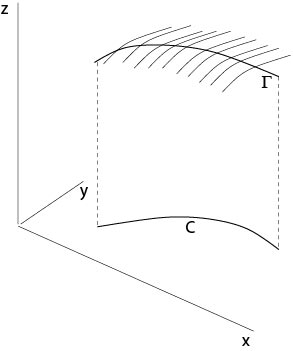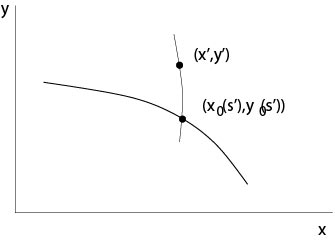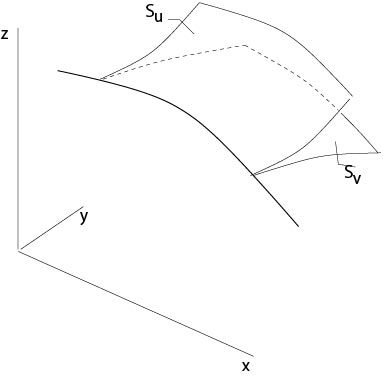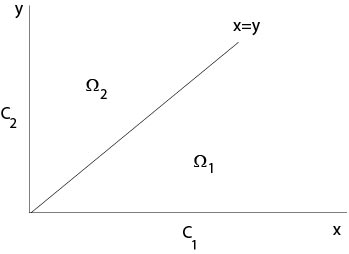2.2.2: Initial Value Problem of Cauchy
( \newcommand{\kernel}{\mathrm{null}\,}\)
Consider again the quasilinear equation
(⋆) a1(x,y,u)ux+a2(x,y,u)uy=a3(x,y,u).
Let
Γ: x=x0(s), y=y0(s), z=z0(s), s1≤s≤s2, −∞<s1<s2<+∞
be a regular curve in R3 and denote by C the orthogonal projection of Γ onto the (x,y)-plane, i. e.,
$$
\mathcal{C}:\ \ x=x_0(s),\ \ y=y_0(s).
\]
Initial value problem of Cauchy: Find a C1-solution u=u(x,y) of (⋆) such that u(x0(s),y0(s))=z0(s), i. e., we seek a surface S defined by z=u(x,y) which contains the curve Γ.

Figure 2.2.2.1: Cauchy initial value problem
Definition. The curve Γ is said to be non-characteristic if
$$
x_0'(s)a_2(x_0(s),y_0(s))-y_0'(s)a_1(x_0(s),y_0(s))\not=0.
\]
Theorem 2.1. Assume a1, a2, a2∈C1 in their arguments, the initial data x0, y0, z0∈C1[s1,s2] and Γ is non-characteristic.
Then there is a neighborhood of C such that there exists exactly one solution u of the Cauchy initial value problem.
Proof. (i) Existence. Consider the following initial value problem for the system of characteristic equations to (⋆):
x′(t)=a1(x,y,z)y′(t)=a2(x,y,z)z′(t)=a3(x,y,z)
with the initial conditions
x(s,0)=x0(s)y(s,0)=y0(s)z(s,0)=z0(s).
Let x=x(s,t), y=y(s,t), z=z(s,t) be the solution, s1≤s≤s2, |t|<η for an η>0. We will show that this set of curves, see Figure 2.2.2.1, defines a surface. To show this, we consider the inverse functions s=s(x,y), t=t(x,y) of x=x(s,t), y=y(s,t) and show that z(s(x,y),t(x,y)) is a solution of the initial problem of Cauchy. The inverse functions s and t exist in a neighborhood of t=0 since
det∂(x,y)∂(s,t)|t=0=|xsxtysyt|t=0=x′0(s)a2−y′0(s)a1≠0,
and the initial curve Γ is non-characteristic by assumption.
Set
u(x,y):=z(s(x,y),t(x,y)),
then u satisfies the initial condition since
u(x,y)|t=0=z(s,0)=z0(s).
The following calculation shows that u is also a solution of the differential equation (⋆).
a1ux+a2uy=a1(zssx+zttx)+a2(zssy+ztty)=zs(a1sx+a2sy)+zt(a1tx+a2ty)=zs(sxxt+syyt)+zt(txxt+tyyt)=a3
since 0=st=sxxt+syyt and 1=tt=txxt+tyyt.
(ii) Uniqueness. Suppose that v(x,y) is a second solution. Consider a point (x′,y′) in a neighborhood of the curve (x0(s),y(s)), s1−ϵ≤s≤s2+ϵ, ϵ>0 small. The inverse parameters are s′=s(x′,y′), t′=t(x′,y′), see Figure 2.2.2.2.

Figure 2.2.2.2: Uniqueness proof
Let
A: x(t):=x(s′,t), y(t):=y(s′,t), z(t):=z(s′,t)
be the solution of the above initial value problem for the characteristic differential equations with the initial data
x(s′,0)=x0(s′), y(s′,0)=y0(s′), z(s′,0)=z0(s′).
According to its construction this curve is on the surface S defined by u=u(x,y) and u(x′,y′)=z(s′,t′). Set
ψ(t):=v(x(t),y(t))−z(t),
then
ψ′(t)=vxx′+vyy′−z′=xxa1+vya2−a3=0
and
ψ(0)=v(x(s′,0),y(s′,0))−z(s′,0)=0
since v is a solution of the differential equation and satisfies the initial condition by assumption. Thus, ψ(t)≡0, i. e.,
v(x(s′,t),y(s′,t))−z(s′,t)=0.
Set t=t′, then
v(x′,y′)−z(s′,t′)=0,
which shows that v(x′,y′)=u(x′,y′) because of z(s′,t′)=u(x′,y′).
◻
Remark. In general, there is no uniqueness if the initial curve Γ is a characteristic curve, see an exercise and Figure 2.2.2.3, which illustrates this case.

Figure 2.2.2.3: Multiple solutions
Examples
Example 2.2.2.1:
Consider the Cauchy initial value problem
ux+uy=0
with the initial data
x0(s)=s, y0(s)=1, z0(s) is a given C1-function.
These initial data are non-characteristic since y′0a1−x′0a2=−1. The solution of the associated system of characteristic equations
x′(t)=1, y′(t)=1, u′(t)=0
with the initial conditions
x(s,0)=x0(s), y(s,0)=y0(s), z(s,0)=z0(s)
is given by
x=t+x0(s), y=t+y0(s), z=z0(s),
i. e.,
x=t+s, y=t+1, z=z0(s).
It follows s=x−y+1, t=y−1 and that u=z0(x−y+1) is the solution of the Cauchy initial value problem.
Example 2.2.2.2:
A problem from kinetics in chemistry. Consider for x≥0, y≥0 the problem
ux+uy=(k0e−k1x+k2)(1−u)
with initial data
u(x,0)=0, x>0, and u(0,y)=u0(y), y>0.
Here the constants kj are positive, these constants define the velocity of the reactions in consideration, and the function u0(y) is given. The variable x is the time and y is the height of a tube, for example, in which the chemical reaction takes place, and u is the concentration of the chemical substance.
In contrast to our previous assumptions, the initial data are not in C1. The projection C1∪C2 of the initial curve onto the (x,y)-plane has a corner at the origin, see Figure 2.2.2.4.

Figure 2.2.2.4: Domains to the chemical kinetics example
The associated system of characteristic equations is
x′(t)=1, y′(t)=1, z′(t)=(k0e−k1x+k2)(1−z).
It follows x=t+c1, y=t+c2 with constants cj. Thus the projection of the characteristic curves on the (x,y)-plane are straight lines parallel to y=x. We will solve the initial value problems in the domains Ω1 and Ω2, see Figure 2.2.2.4, separately.
(i) The initial value problem in Ω1. The initial data are
x0(s)=s, y0(s)=0, z0(0)=0, s≥0.
It follows
x=x(s,t)=t+s, y=y(s,t)=t.
Thus
z′(t)=(k0e−k1(t+s)+k2)(1−z), z(0)=0.
The solution of this initial value problem is given by
z(s,t)=1−exp(k0k1e−k1(s+t)−k2t−k0k1e−k1s).
Consequently
u1(x,y)=1−exp(k0k1e−k1x−k2y−k0k1e−k1(x−y))
is the solution of the Cauchy initial value problem in Ω1. If time x tends to ∞, we get the limit
$$
\lim_{x\to\infty} u_1(x,y)=1-e^{-k_2y}.
\]
(ii) The initial value problem in Ω2. The initial data are here
x0(s)=0, y0(s)=s, z0(0)=u0(s), s≥0.
It follows
x=x(s,t)=t, y=y(s,t)=t+s.
Thus
z′(t)=(k0e−k1t+k2)(1−z), z(0)=0.
The solution of this initial value problem is given by
z(s,t)=1−(1−u0(s))exp(k0k1e−k1t−k2t−k0k1).
Consequently
u2(x,y)=1−(1−u0(y−x))exp(k0k1e−k1x−k2x−k0k1)
is the solution in Ω2.
If x=y, then
u1(x,y)=1−exp(k0k1e−k1x−k2x−k0k1)u2(x,y)=1−(1−u0(0))exp(k0k1e−k1x−k2x−k0k1).
If u0(0)>0, then u1<u2 if x=y, i. e., there is a jump of the concentration of the substrate along its burning front defined by x=y.
Remark. Such a problem with discontinuous initial data is called Riemann problem. See an exercise for another Riemann problem.
The case that a solution of the equation is known
Here we will see that we get immediately a solution of the Cauchy initial value problem if a solution of the homogeneous linear equation
a1(x,y)ux+a2(x,y)uy=0
is known.
Let
x0(s), y0(s), z0(s), s1<s<s2
be the initial data and let u=ϕ(x,y) be a solution of the differential equation. We assume that
ϕx(x0(s),y0(s))x′0(s)+ϕy(x0(s),y0(s))y′0(s)≠0
is satisfied. Set
g(s)=ϕ(x0(s),y0(s))
and let s=h(g) be the inverse function.
The solution of the Cauchy initial problem is given by u0(h(ϕ(x,y))).
This follows since in the problem considered a composition of a solution is a solution again, see an exercise, and since
$$
u_0\left(h(\phi(x_0(s),y_0(s))\right)=u_0(h(g))=u_0(s).
\]
Example 2.2.2.3:
Consider equation
ux+uy=0
with initial data
x0(s)=s, y0(s)=1, u0(s) is a given function.
A solution of the differential equation is ϕ(x,y)=x−y. Thus
ϕ((x0(s),y0(s))=s−1
and
u0(ϕ+1)=u0(x−y+1)
is the solution of the problem.
Contributors and Attributions
Integrated by Justin Marshall.


